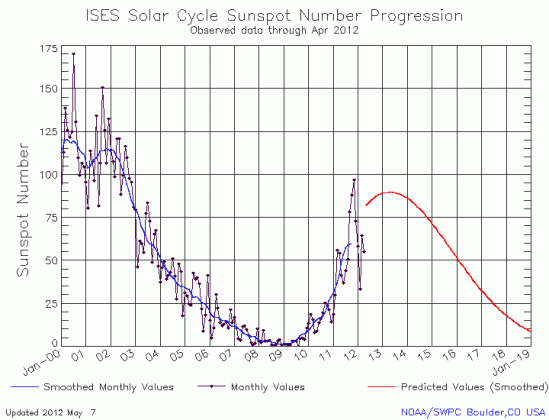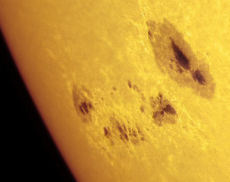The Sun fizzles in April
NOAA’s Space Weather Prediction Center today posted its monthly update of the ongoing sunspot cycle of the Sun. I have posted the new graph for April below the fold.
As I have noted for the past year, the Sun has followed a very consistent up-and-down pattern as it has ramped up to solar maximum. Several months of steep sunspot number increase is then followed by several months of sunspot number decline. Since the increase has always been more than the decline, the sum has thus produced the rise toward maximum.
In March the Sun’s activity jumped upward after three months of steep decline. If the up-and-down pattern described above was to continue, the Sun’s activity should have continued to rise in April. It did not. Instead, the number of sunspots dropped.

Not only does this drop fail to show a ramp up to solar maximum, it also makes difficult the predictions of solar scientists for the magnitude of the upcoming solar maximum. If you look closely at this month’s graph, you will see that the blue line that shows the overall trends has ceased going up, but instead shows a stall. It seems increasingly unlikely that the maximum will reach the predicted numbers as shown by the red line of the graph.
Not surprisingly, the solar scientists at the Marshall Space Flight Center have once again revised their prediction for the upcoming solar maximum, dropping their predicted sunspot number at maximum from 61 to 60, noting as they have earlier that this maximum will be the weakest in a hundred years.
Meanwhile, the public relations machine at NOAA is gearing up for its annual Space Weather Enterprise Forum, where they spend a day convincing credulous reporters who don’t know very much and like to believe everything a government worker tells them that we are all going to die from the upcoming solar maximum. As their press release and webpage states so threateningly:
As we approach the next peak of solar activity expected in 2013, our Nation faces multiplying uncertainties from increasing reliance on space weather-affected technologies for communications, navigation, security, and other activities, many of which underpin our national infrastructure and economy. We also face increasing exposure to space weather-driven human health risks as trans-polar flights and space activities, including space tourism and space commercialization, increase.
As I noted last year, this annual PR campaign has almost nothing to do with the real story — that the Sun continues to under perform predictions — and more to do with drumming up funding from Congress.

Obviously, the PR people at NOAA think that they have to convince everyone that the Sun is going to fry us in order to get money from Congress for new facilities and Sun-tracking satellites. And it is true that even during this weak maximum the Sun can still be dangerous. For example, one of the largest sunspots in years (shown on the left) has appeared on the Sun’s face, and is slowly rotating into a position where it could send a flare and coronal mass ejection directly at the Earth. Understanding this process and being able to predict and track it is essential in order to protect our modern technological society.
Nonetheless, crying wolf is not a good way to convince anyone that this research needs to be done. By focusing on the threat of a strong maximum — when a weak maximum is coming — NOAA risks losing all credibility. Moreover, even if NOAA should get its funding, it will do so under a false pretense that will require it to study the wrong thing — a strong maximum — when the real need is to study a Sun that might not be producing any sunspots at all.
Rather than falsely claiming that the upcoming solar maximum is going to be deadly, NOAA’s PR people should focus on our need to understand why the Sun’s solar cycle shifts from strong and weak cycles, and even sometimes shuts down its production of sunspots entirely, for decades at a time. As I even noted earlier today, there is growing evidence that the Sun’s solar cycle has a significant influence on the Earth’s climate, with a lack of sunspots strongly linked to a cooling climate. And if the Sun is about to enter another Grand Minimum, with no sunspots for decades at a time, we need to know how much that lack is going to cool the climate of the Earth in the coming decades.
On Christmas Eve 1968 three Americans became the first humans to visit another world. What they did to celebrate was unexpected and profound, and will be remembered throughout all human history. Genesis: the Story of Apollo 8, Robert Zimmerman's classic history of humanity's first journey to another world, tells that story, and it is now available as both an ebook and an audiobook, both with a foreword by Valerie Anders and a new introduction by Robert Zimmerman.
The print edition can be purchased at Amazon or from any other book seller. If you want an autographed copy the price is $60 for the hardback and $45 for the paperback, plus $8 shipping for each. Go here for purchasing details. The ebook is available everywhere for $5.99 (before discount) at amazon, or direct from my ebook publisher, ebookit. If you buy it from ebookit you don't support the big tech companies and the author gets a bigger cut much sooner.
The audiobook is also available at all these vendors, and is also free with a 30-day trial membership to Audible.
"Not simply about one mission, [Genesis] is also the history of America's quest for the moon... Zimmerman has done a masterful job of tying disparate events together into a solid account of one of America's greatest human triumphs."--San Antonio Express-News


I just LOVE how people like to coeptelmly under-estimate nature’s ability to fight back. Humans have so screwed up the planet that just maybe, the planet won’t fully protect us like it used to. Yes power grids can be knocked out and other electronic equipment can be seriously damaged at random by these flares and storms, and yes, such damage has been reletively minimal in the past as far as we know.However, what people fail to realize is that these cycles can and will cause serious issues beyond electronic failure. And despite most people’s attitude of yeah whatever , it HAS caused devastation in the past, whether we humans were around to record the events or not is irrelevant.The potential is there, we must simply do the logical thing, prepare for the worst and hope for the best. Thus, in all likelihood, events will fall somewhere in the middle and we will come out of it relatively unharmed.Preparing for worst case scenario with solar storms is no different than preparing yourself when big storms roll in and tear up things at ground level, such as wind and electrical storms, flooding, etc.I live in the Pacific North West and it just amazes me how coeptelmly unprepared the vast majority of the local population is when the winter storms roll in as they do EVERY YEAR and cause flooding and other damage to the area. I simply sit back calmly, prepared for potential power failure and other problems while most others are scrambling like mad buying up water, candles, and other emergency supplies.It often makes me wonder: Are people really that dense that they simply can not learn? O.o If that is the case, I wonder how the heck humans have survived for so long, honestly